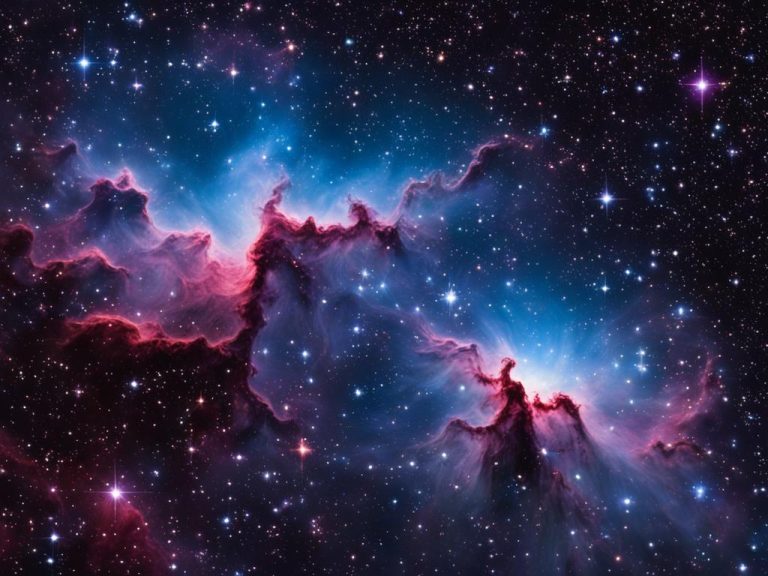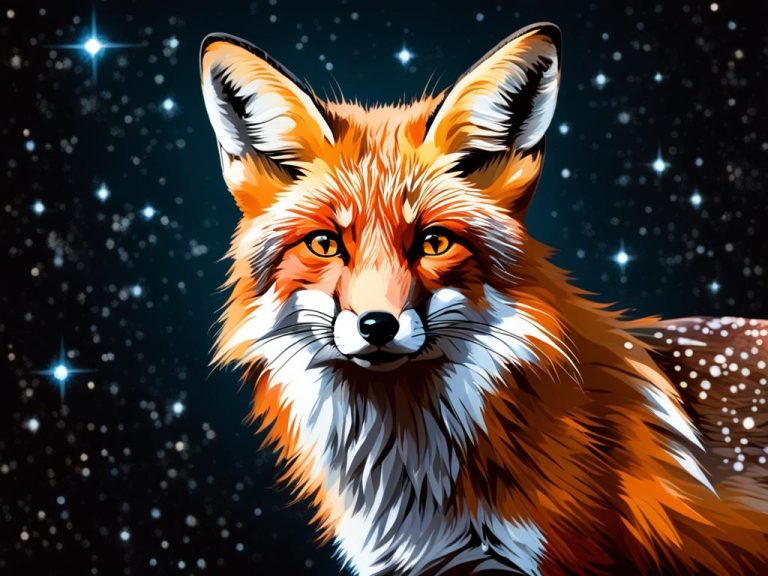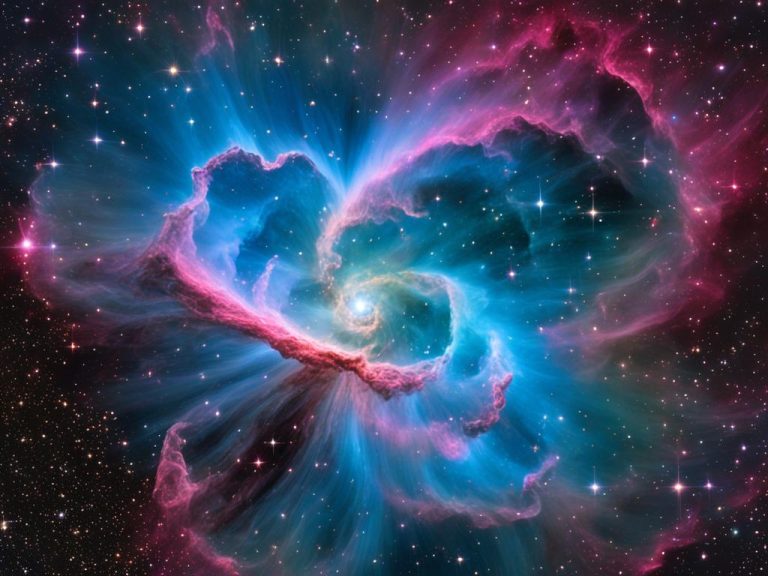Unveiling the Mysteries of the Vulpecula Constellation
Did you know that “Vulpecula” means “little fox” in Latin? This constellation is not famous like others. But it still has big meaning in the sky. Vulpecula is in the northern part of the sky. It has many interesting things to see, like stars and myths.

Key Takeaways:
- Vulpecula Constellation, meaning “little fox” in Latin, is located in the northern sky.
- Introduced by astronomer Johannes Hevelius in the seventeenth century, Vulpecula has significant astronomical significance.
- Vulpecula offers a captivating array of celestial objects, star patterns, and enigmatic myths.
- Naming a star in Vulpecula can be a perfect and unique gift for any occasion.
- Stay tuned to learn more about the fascinating history, mythology, and stunning features of Vulpecula Constellation.
Unveiling the Mysteries of Vulpecula Constellation
In the night sky, you can see the Vulpecula Constellation. Astronomers and stargazers have loved it for ages. It’s called the “Little Fox” and shows us the universe’s grandeur and beauty.
The Dumbbell Nebula, or Messier 27, is one star in Vulpecula. It looks like a dumbbell and is easily visible. This nebula is a beautiful sight.
Telescopes of 6 inches or more let us see the Dumbbell Nebula clearly. We can then see its beautiful details. Photogs use long exposures to get amazing shots of it.
Software can stack photos to make one great image of the Dumbbell Nebula. This makes the nebula look even more stunning.
People love astronomy and taking photos of the sky. Joining clubs and forums lets them share their work. It’s a great way to meet others with the same interests.
For more about the night sky, check out the beginner’s guide to constellations. You can also learn about the Nova of 1670 and the Dumbbell Nebula here. For tips on seeing the Dumbbell Nebula, visit Stargazing Ireland.
History and Mythology of Vulpecula Constellation
Exploring the night sky reveals the rich history and myths behind the Vulpecula constellation. This constellation, though less known, has its own fascinating tales.
“Vulpecula” hints at its mythological roots, coming from the Latin for fox. It is linked to foxes’ clever, elusive nature. Ancient people saw foxes as clever and linked them to trickery.
The exact stories about Vulpecula’s myths are not clear. Its name shows how navigating the sky is like a fox finding its way. The constellation shows the challenge and mystery of finding where you are among the stars.
As we learn more about Vulpecula, it keeps astronomers and people looking at the stars interested. Its history and myths make the sky even more magical.
Naming a Star in Vulpecula
Looking for a special gift? Consider naming a star in the Vulpecula Constellation. International Star Registry helps you do this. You can keep a loved one’s name shining in the night sky.
When you name a star for someone, it’s a one-of-a-kind present. It suits any happy occasion. Just think of the happiness they’ll feel when they see their named star on a certificate and sky map.
International Star Registry began in 1979. It’s known for naming stars. You can rely on their expertise for a star gift that lasts forever.
Naming a star helps with space research too. It supports scientists in learning more about the universe. So, your gift keeps on giving beyond its beauty.
Naming a star in Vulpecula is a meaningful way to honor someone. It’s perfect for showing love or remembering someone special. Go to International Star Registry’s site to start your star-naming adventure today.

The Celebrities of Vulpecula
Within the Vulpecula Constellation, some stars are really famous. They’re known not just for their place in the sky but also for being named after well-loved celebrities.
One special star is named after Isabel Sanford. She was famous for playing Weezy in “The Jeffersons.” This star is a tribute to her amazing acting.
Another star shines bright with Lacey Chabert‘s name. She acted in movies like “Mean Girls” and was Eliza in “The Wild Thornberrys.” Now, she’s remembered in the skies too.
There are more stars named after other famous people in Vulpecula. It’s a special way to honor these celebrities.
People name these stars for many reasons. It could be to remember someone special or to celebrate an event. When you buy a star for someone Through International Star Registry, it’s a gift that lasts forever in the night sky.
The Perfect Gift in Vulpecula Constellation
Imagine immortalizing a special moment or cherished memory among the stars. With International Star Registry, you can do just that by naming a star within the Vulpecula constellation. Whether it’s a birthday, Christmas, or anniversary, naming a star is a unique and timeless gift that will shine brightly for eternity.
By purchasing a star through International Star Registry, you not only bestow a personalized and meaningful gift but also contribute to ongoing astronomical research and exploration. Each star comes with a beautifully crafted certificate and star map, allowing you to locate your named star in the night sky.
When you buy a star from International Star Registry, you do more than just give a star gift. International Star Registry is a trusted place where you can name a star after someone. They will send you a special certificate and a star chart.
The Vulpecula Constellation is the world’s 55th largest, out of 88 constellations. It shines in the fourth quadrant of the northern sky. You can easily spot it as it sits in the Summer Triangle’s center. This makes it stand out among the stars. In Vulpecula, there are many amazing things to see. For example, there’s the Dumbbell Nebula (M27), which looks stunning from 1,360 light-years away. Also, you can find the NGC 6823 and Stock 1 open star clusters. There’s a lot to explore and enjoy.
The brightest star in Vulpecula is Alpha Vulpeculae, also known as Anser. It’s a red giant and shines bright in the night sky. Also, this area is home to four stars with planets. It shows how diverse and interesting our universe is.
Vulpecula is connected to Greek myths, adding a mystical touch to the gift. It tells the story of a little fox and Zeus’s decision to place him in the stars. It’s a tale that makes the gift even more special.
Buying a star here gives more than a gift. It represents the unique and lasting place of your loved one in the universe. So for any celebration, a star in Vulpecula is the perfect choice. It’s a beautiful way to honor someone.
Thinking of getting a star in Vulpecula Constellation? Check out International Star Registry’s website. There, you can find the best star name for your special someone. Today, start a meaningful journey that will last a lifetime!
Witnessing the Dazzling Beauty of the Dumbbell Nebula
The Dumbbell Nebula is a part of the Vulpecula Constellation. It’s also called Messier 27. This nebula captivates all who look at it, with its detailed design and bright colors. Anyone who looks at it through a telescope is in for a treat.
This nebula got its name from its shape – like a dumbbell or a barbell. It has a center star and a shell of gas and dust around it. This shows how beautiful and detailed space can be. It’s a true wonder of the universe.
A telescope is crucial to see the Dumbbell Nebula well. Its light is too weak for our eyes alone. But with a telescope, you can see its fine details and soft colors. It’s a must-see for anyone who loves the stars or studies them.
Want to hold on to the beauty of the Dumbbell Nebula? Try astrophotography. With the right tools and a long exposure method, you can take amazing pictures. These photos will show every bit of this stunning cosmic sight.
The Dumbbell Nebula is an incredible adventure for anyone interested in space. Its charm and grandeur will stay with you – whether you’re just starting to look up at the sky, or you’re a seasoned photographer. It truly shines a light on the universe’s beauty.

Preparation and Techniques for Observing the Dumbbell Nebula
The Dumbbell Nebula is a stunning sight in the sky for those who love stars. It’s found in the Vulpecula constellation. Anyone who enjoys looking at the stars should see this. But, you need the right tools and know-how to fully enjoy its beauty.
To see the Dumbbell Nebula, a good telescope is a must. It should have a big enough aperture. This makes the nebula look sharper and more detailed. Great telescopes for this job are the Celestron NexStar 8SE or the Orion SkyQuest XT10.
With the telescope set, time to pick the right gear. Eyepieces of different focal lengths help adjust how closely you see the nebula. A Barlow lens also boosts the view’s clarity and details.
Using filters can make your observation even better. A Hα filter can highlight the nebula’s details by showing its special light. Or, a light pollution filter can lessen city lights’ effect, making the sky clearer.
The place you observe from matters a lot. Go somewhere free of city lights and light pollution. Rural or remote areas are best. They offer a clear, uninterrupted view of the night sky and the Dumbbell Nebula.
Observing the Dumbbell Nebula needs patience. Let your eyes adjust to the dark slowly. Avoid bright lights or screens before you look. This keeps your eyes adapted to see the nebula well in the dark.
With these tips, you’re ready to see the amazing Dumbbell Nebula. It’s a chance to be amazed by the universe. Whether you’re just starting or already deep into astronomy, this experience will leave you stunned by the universe’s scale and beauty.
Photographing the Dumbbell Nebula
Photographing the Dumbbell Nebula is both exciting and challenging. It requires special gear and skills. This will bring out its true beauty.
To start, you’ll need a camera that can do long-exposure shots. A tripod keeps the camera steady. This is key for clear photos.
The lens you use changes how detailed your image is. Try different focal lengths to see what works. For instance, one setup had a 480mm lens, while another used a 1050mm. These show how important the right lens is.
Image stacking helps make your photos clearer. It combines many shots into one. This decreases noise and makes your photo sharp.
Using H-Alpha filters adds rich reds to your image. This makes the Dumbbell Nebula look even better. It’s all about enhancing the details.
Choosing the best telescope and camera is vital. And the Sky-Watcher Esprit 150 and Starlight Xpress CCD are great. They capture the Nebula’s beauty.
The longer you expose your shot, the more details you’ll see. This part can vary depending on your setup. Sometimes you need over an hour.
Starting with a basic telescope is fine. It gets you into astrophotography. Consider a 4.5″ Dobsonian for your first telescope.
Try different filters and cameras to see what works for you. There’s a lot to explore in astrophotography. Let your creativity flow.
Remember, the Dumbbell Nebula is in the Vulpecula constellation. It’s made by a white dwarf, showing beautiful patterns and colors. Capturing these is every astrophotographer’s dream.
So set up your gear on a clear night. And start capturing the amazing Dumbbell Nebula.
Conclusion
The Vulpecula Constellation takes us on a fascinating journey through the stars. It’s a must-see for anyone who loves looking at the sky. Vulpecula has a long history and important discoveries in astronomy. Johannes Hevelius first showed us this area in the sky in the late 17th century.
The Dumbbell Nebula, or Messier 27, stands out in Vulpecula. It’s a beautiful planetary nebula 1,360 light years from Earth. This nebula looks like an hourglass and shines a bright green. This green comes from special kinds of oxygen.
Vulpecula shows us the amazing things in space. You can learn about its myths, look at its stars, or just enjoy the view. Vulpecula is an open invitation to explore the universe’s wonders.
FAQ
What is the Vulpecula Constellation?
The Vulpecula Constellation means “little fox” in Latin. It’s in the northern sky. It has many important celestial objects.
What can I observe in the Vulpecula Constellation?
You can see the Dumbbell Nebula (Messier 27) here. Other interesting things are waiting to be discovered.
How can I name a star in the Vulpecula Constellation?
Name a star there through International Star Registry. You get a star map and a certificate with your name on it.
Have any celebrities named stars in the Vulpecula Constellation?
Yes, famous people like Isabel Sanford and Lacey Chabert have named stars here.
Is naming a star in Vulpecula Constellation a unique gift?
Giving a star name in Vulpecula is incredibly special. It’s a unique and lasting gift idea.
What is the Dumbbell Nebula?
The Dumbbell Nebula is in Vulpecula, also known as Messier 27. It’s a beautiful object about 1,360 light-years from us.
What can I expect to see in the Vulpecula Constellation?
In Vulpecula, you can see many beautiful celestial objects. The Dumbbell Nebula is just one of many sights. It’s a place to enjoy the universe’s beauty.
Source Links
- Unveiling the Splendor: A Guide to Observing the Dumbbell Nebula – https://stargazingireland.com/observing-the-dumbbell-nebula/
